Abstract
In collapsible loess sites, large-scale collapsible settlement may occur after water immersion, which will reduce the bearing capacity of existing highway bridge pile foundations and pose serious potential safety hazards. Given this, a large-scale field pile foundation immersion–loading test was conducted in a collapsible loess site. The settlement law of collapsible loess during the immersion was obtained, the bearing characteristics of pile foundations under the loading and immersion–loading conditions were compared and analyzed, and the formation mechanism of negative skin friction was discussed. The results show that the degree of collapsible deformation is related to the duration of immersion, external load, boundary conditions, and soil layer depth. Whether the collapsible loess site is immersed or not can only change the value and transfer rate of the axial force of the pile foundation but cannot change its transfer law. The collapsible deformation will increase the utilization rate of the pile tip resistance. During the collapsible settlement process, part of the gravity of the soil around the pile will be transferred to the pile, generating negative skin friction on the pile shaft. On this basis, eight preventive measures for reducing the negative skin friction of pile foundations in collapsible loess sites were proposed. The research findings can serve as a valuable reference for the design and construction of highway bridge pile foundations in collapsible loess areas.
1. Introduction
Loess is a particular kind of unsaturated soil and belongs to Quaternary sediments [1]. It is widely distributed, accounting for about 10% of the total land area of the Earth [1,2,3]. During the eolian and recent deposition of loess, the influence of specific geological agents, environmental conditions, sources, and other factors can lead to collapsibility due to macroporosity and water sensitivity [4]. In the study of the mechanical behavior of loess, researchers have always been concerned about the collapsibility of loess and the engineering problems it causes [1]. Bridges play a crucial role in the development of highways and are essential infrastructure for the economic and social progress of a country [5,6]. With the rapid economic and transportation developments in the northwest region of China, an increasing number of highway bridges were constructed in the loess area [7,8]. Pile foundation is an ancient foundation form that is also the most widely used foundation or support structure for buildings to this day [9,10,11]. Due to their high bearing capacity, good stability, and simple construction process, pile foundations are widely used in highway bridge foundations [12]. The collapsible loess will experience collapsible deformation when encountering water, resulting in a sudden increase in the settlement of pile foundations for highway bridges under normal service conditions and reducing their bearing capacity, which will seriously affect the safety of the superstructure of the highway bridge [13,14,15,16]. Therefore, it is crucial to investigate the bearing characteristics of highway bridge pile foundations under water immersion in collapsible loess areas.
An important issue that arises from the immersion of collapsible loess is the negative skin friction exerted on the pile shaft [17]. Negative skin friction not only fails to resist the vertical load at the pile top, but instead becomes a downward vertical load to the pile shaft [18]. Scholars have researched the negative skin friction of piles and achieved many research results [19,20,21,22,23,24,25,26,27,28,29]. However, there is an essential difference between collapsible settlement and consolidation settlement. Therefore, the issue of negative skin friction in the collapsible loess area also has significant differences from that in the soft soil and fill areas. In recent years, scholars have researched the bearing characteristics and negative skin friction of pile foundations in collapsible loess areas through theoretical analysis and numerical simulation [17,30,31]. However, these two methods are influenced by factors such as the properties of collapsible loess, settlement rate, and stabilization time. They can only provide some qualitative conclusions and still require further validation through field tests. Although conducting large-scale immersion tests requires a significant amount of funding and time, they remain the most effective research method [17]. Only a small number of scholars have conducted on-site immersion–loading tests of pile foundations in the loess area [32,33]. They have studied the changes in the bearing characteristics of pile foundations before and after immersion and analyzed the negative skin friction generated on the pile shaft due to the collapsible deformation. However, it is important to note that in actual engineering, the pile top still bears the vertical load during the collapsible deformation process of the loess. This aspect was not taken into account in their tests.
Due to the fact that the water immersion failure mechanism for highway bridge pile foundations is not yet clear, and corresponding preventive measures are lacking, a large-scale on situ pile foundation immersion–loading test was conducted. This test was conducted with the following aims: (1) compare and analyze the bearing characteristics of pile foundations under the loading and immersion–loading conditions in collapsible loess sites; (2) clarify the formation mechanism of negative skin friction of pile foundations in collapsible loess sites; and (3) propose preventive measures for negative skin friction of pile foundations in collapsible loess areas. The research findings can provide guidance for the design and construction of pile foundations for highway bridges in collapsible loess areas.
2. Field Testing
2.1. Test Site
As shown in Figure 1, the test site was located near the Northeast Second Ring Overpass in Weiyang District, Xi’an City, Shaanxi Province, China. Xi’an has a warm temperate humid monsoon climate, with rainfall concentrated mainly in July, August, and September. The annual average rainfall is 604 mm, and the relative humidity is 0.7. The test site was a self-weight collapsible loess site, and the collapsibility grade was II. There was no surface water distribution in the test site, and groundwater distribution was not present in the range of the borehole depth. The characteristics of the soil in the test site are detailed in Table 1.
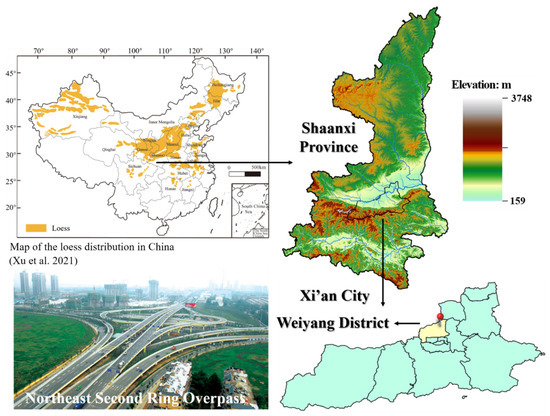
Figure 1.
Location of test site [3].

Table 1.
The properties of the soil in the test site.
2.2. Test Scheme
The test piles were two bored cast-in-place piles, numbered S1 and S2. Each pile had a length of 18.7 m and a diameter of 0.8 m, with a penetration depth of 17.5 m. The range within 1.2 m from the top of the pile adopted C40 concrete, and the remaining part adopted C30 concrete. The anchor piles were also bored cast-in-place piles, with a length of 17.7 m and a diameter of 0.8 m, and C25 concrete was adopted.
In order to obtain the bearing characteristics of the test piles when the load acts and the loess collapsibility occurs, as shown in Figure 2, starting from 0.7 m downward from the pile top, a test section was set up every 1.5 m. Four reinforcement stress gauges were evenly installed in each test section, and four earth pressure cells were symmetrically installed at the tip of the test piles. The model of the reinforcement stress gauges was JXG-1, with a range of −40 kN to 60 kN. The model of the earth pressure cell was YT-ZX-0300, with a range of 0.1 MPa to 6.0 MPa. The data were collected using the ZXY-3 data acquisition instrument.
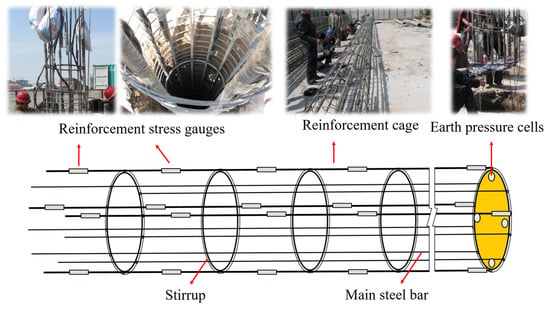
Figure 2.
Arrangement of instruments on reinforcement cage.
After the reinforcement cages of the test piles and anchor piles were placed in the drill holes, concrete was poured. To prevent the concrete at the top of the test piles from being damaged during the loading, the steel casing was not pulled out after the concrete pouring was completed, so that the concrete at the top of the test piles was bonded together with the steel casing. After the concrete strength of the test piles reached the requirements of the specification, the reaction frame equipment was assembled, as shown in Figure 3. Four automatic displacement acquisition instruments were evenly installed at the test pile top to measure the settlement.
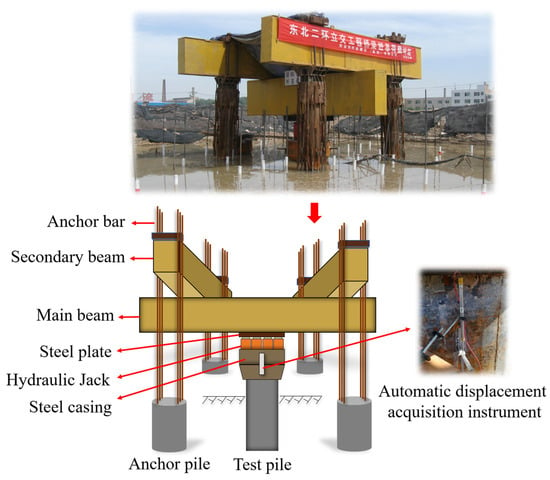
Figure 3.
Reaction frame equipment.
As shown in Figure 4, a square water immersion pit with a side length of 20 m and a depth of 0.5 m was excavated around the S1 test pile, and 0.2 m of sand–gravel was laid at the bottom of the test pit. Under the natural moisture, the S2 test pile was incrementally loaded until failure, and the S1 test pile was incrementally loaded to the design load. After the settlement of the S1 test pile became stable, the vertical load was kept unchanged, and water injection commenced in the test pit, with the water head maintained at 30 cm. The designed water injection volume was three times the maximum monthly rainfall in the Xi’an area over the years, which is 335 m3. Considering factors such as evaporation and potential errors in water transport by trucks, the actual water injection volume exceeds the planned amount by 45 m3, totaling 380 m3. After the water immersion settlement stabilized, the S1 test pile was incrementally loaded to failure.
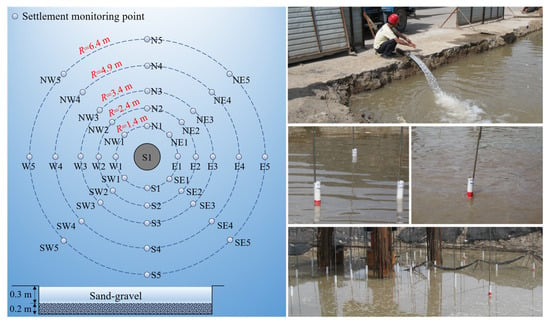
Figure 4.
Water immersion pit and settlement monitoring points.
As shown in Figure 4, a total of five circles of settlement monitoring points were set around the S1 test pile to observe the collapsible deformation of the soil around the pile during the immersion. The settlement monitoring points consist of metal cylinders inserted to the desired monitoring depth and steel bars, which were monitored using a total station for the settlement of the top of the steel bars during immersion, thereby reflecting the soil settlement around the S1 test pile. The depths of each settlement monitoring point are shown in Table 2.

Table 2.
Depths of each settlement monitoring point.
2.3. Test Results
2.3.1. Settlement of Soil Around S1 Test Pile During Immersion
The settlement of each monitoring point of the soil around the S1 test pile during the immersion is shown in Figure 5.
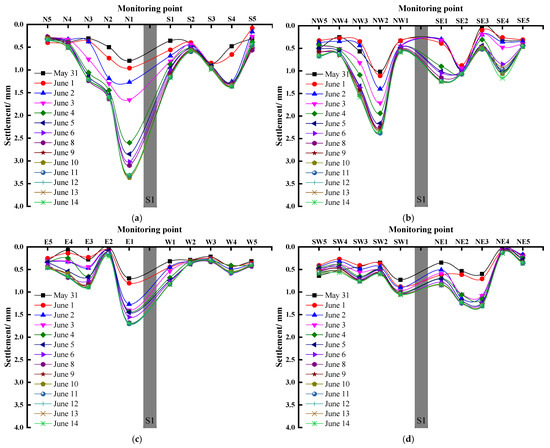
Figure 5.
Settlement of soil around S1 test pile during immersion: (a) north-south direction; (b) northwest-southeast direction; (c) east-west direction; (d) southwest-northeast direction.
The water injection into the test pit began on 30 May and ended on 3 June. It took 15 days until the settlement of the soil around the S1 test pile became stable. This indicates that the collapsible deformation of the loess after immersion is a process. It does not undergo significant collapsible deformation as soon as it encounters water. Instead, it gradually increases over time and eventually stabilizes.
The soil far from the S1 test pile was laterally confined by the non-immersed soil at the edge of the test pit, while the soil around the S1 test pile was unconfined. Moreover, the downward displacement of the S1 test pile under the design load played a certain driving role, resulting in a relatively large settlement of the soil near the S1 test pile.
2.3.2. Settlement of Test Piles During Loading
The relationship between the settlement and load of the test piles is shown in Figure 6.
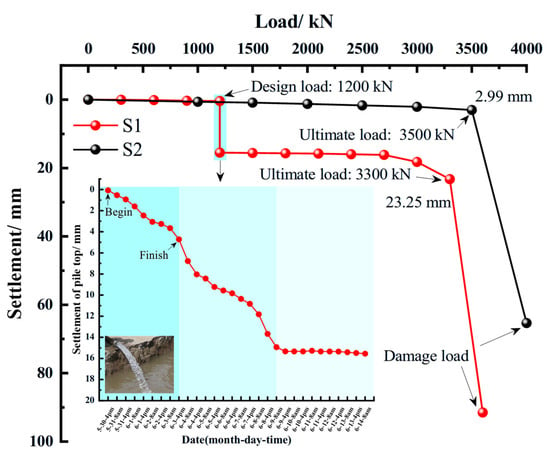
Figure 6.
Relationship between settlement and load of test piles.
During the immersion of the loess, collapsible deformation occurred, causing the settlement of the S1 test pile under the design load. The settlement tended to be stable after 15 days, and the cumulative settlement was 15.5 mm. The ultimate bearing capacities of the S2 test pile and the S1 test pile were 3500 kN and 3300 kN, respectively, and the cumulative settlements were 2.99 mm and 23.25 mm, respectively. Therefore, for the pile foundation in the loess area under the design load, immersion will cause the settlement of the pile foundation, weaken its bearing capacity, and affect the stability of the superstructure.
2.3.3. Axial Force and Tip Resistance of Test Piles
The axial force and tip resistance of the test piles under different loads are shown in Figure 7 and Figure 8.
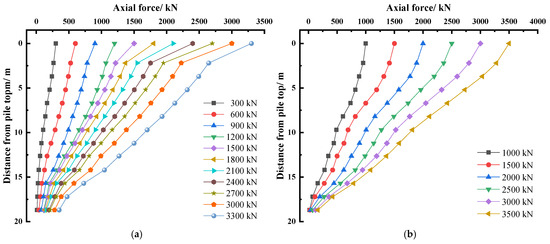
Figure 7.
Axial force of test piles: (a) S1; (b) S2.
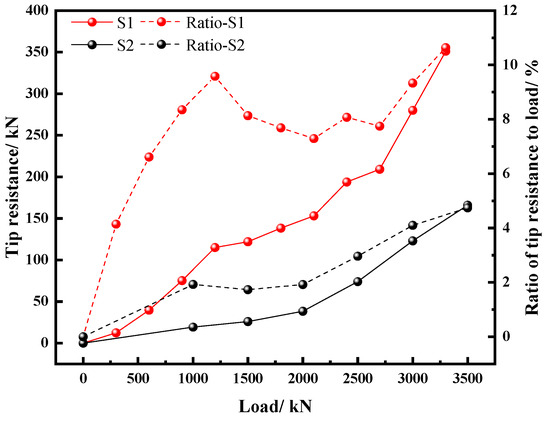
Figure 8.
Tip resistance of test piles.
It can be observed from Figure 7 and Figure 8 that the axial force distribution laws of test piles S1 and S2 under different loads were similar. The axial force at the same position increased with the increase in the load, and the axial force under the same load decreased with the increase in the pile depth. With the increase in the vertical load, the shaft resistance during the downward load transfer gradually increased. Meanwhile, the load transferred to the pile tip gradually increased, and the pile tip soil gradually exerted its bearing capacity. Under the ultimate load, the tip resistances of the S1 and S2 test piles accounted for 10.64% and 4.74% of the total load, respectively.
Therefore, water immersion in the loess area can only change the value and transfer rate of the axial force but cannot change its transfer law. At the same time, the collapsible deformation caused by water immersion of the loess around the pile will increase the utilization rate of the pile tip resistance.
2.3.4. Shaft Resistance of Test Piles
The shaft resistances of the test piles under different loads are shown in Figure 9.
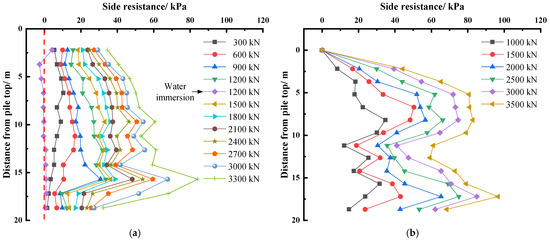
Figure 9.
Shaft resistance of test piles: (a) S1; (b) S2.
It can be determined from Figure 9 that the negative skin friction on the shaft of the pile occurred during the immersion under the constant design load. The maximum intensity of the negative skin friction was 2.2 kPa, and the neutral point was located at the depth of 12.2 m of the pile. Under the ultimate load, the positive skin friction of the S1 and S2 test piles were 84.2 kPa and 96.6 kPa, respectively.
Combined with the field test results and Figure 10, it can be determined that when the collapsible loess around the pile is in its natural moisture content state, the pile foundation is relatively stable and has a very small settlement under the superstructure load. When the collapsible loess around the pile is affected by external water (such as rainfall), a large collapsible settlement will occur. During the settlement process, part of the gravity of the soil around the pile will be transferred to the pile, generating a downdrag on the pile shaft, namely negative skin friction. When the settlement of the pile is the same as that of the soil around the pile, the relative displacement between the two is zero, and there is no skin friction. Here is the neutral point, and the plane where it is located is the neutral plane. At the same time, when negative skin friction occurs, positive skin friction disappears. To bear the superstructure load and the generated negative skin friction, the positive skin friction on the pile shaft below the neutral point and the bearing capacity of the soil at the pile tip will be fully exerted. Therefore, greater relative displacement between the pile and the soil, as well as compression deformation of the pile tip soil will occur. Meanwhile, as the negative skin friction increases the load on the pile shaft, the pile will bear greater compressive deformation, resulting in a reduction in the existing bearing capacity of the pile foundation.

Figure 10.
Formation mechanism of negative skin friction.
3. Preventive Measures
3.1. New Type of Pile Foundation
Some new type of pile foundations can be adopted to reduce the influence of negative skin friction on the pile foundations in the collapsible loess areas after immersion.
As shown in Figure 11, the belled or multi-belled piles are a new type of variable cross-section pile foundation that was developed and formed based on the traditional bored cast-in-place pile technology [34,35,36]. At an appropriate part of the pile shaft, a special squeezing and expanding device is used to form a bearing plate, increasing the contact area between the pile and the soil. Making the bearing capacity of the soil layer where the bearing plate is located fully exerted, can effectively increase the bearing capacity of the pile foundation and reduce the negative skin friction of the pile shaft.
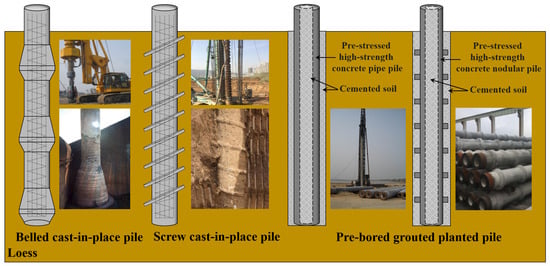
Figure 11.
New type of pile foundations.
The screw piles are a new type of variable cross-section pile foundation that was developed and formed based on the traditional bored cast-in-place pile technology [37,38]. The screws on the pile shaft can cause mechanical interlocking between the pile and the soil, changing the contact mode between the pile shaft and the soil, and can effectively enhance the pile shaft resistance. And due to the special pile-forming technology of the screw pile, the drill pipe exerts a soil compacting effect on the soil around the pile during the hole-forming process, which can effectively enhance the bearing capacity of the pile foundation.
The pre-bored grouted planted pile is a new type of pile foundation. The pre-bored grouted planted pile consists of a pre-stressed high-strength concrete pile or pre-stressed high-strength concrete nodular pile and the grout column around the pile [39,40]. Previous research has demonstrated that the bearing capacity of the pre-bored grouted planted piles is better than that of traditional bored cast-in-place piles [41,42,43,44].
3.2. Post-Grouting Method
We believe that the post-grouting method can be adopted to strengthen the connection between the tip and shaft of the pile foundations and the surrounding soil [8], increase the bearing capacity, and reduce the influence of negative skin friction on the pile foundations in the collapsible loess areas after immersion. However, this method is only applicable to the cast-in-place piles.
As shown in Figure 12, the reinforcement of the cast-in-place piles by post-grouting at the pile tip is mainly reflected in the following four aspects: (1) After the slurry is injected, it reinforces the sediment and soil at the pile tip under different actions such as penetration, compaction, and splitting, effectively improving the bearing capacity of the pile tip. (2) Post-grouting creates an enlarged head at the pile tip, which in turn increases the bearing area and enhances the bearing capacity of the pile tip. (3) The injected slurry flows back along the interface between the pile and the soil, reinforcing the mudcake on the shaft of the pile and compacting the soil around the pile. This process increases the resistance and roughness of the shear interface on the shaft of the pile thereby enhancing the shear strength of the interface between the pile and the soil. (4) Under high pressure, the slurry will pre-compress the pile, leading to the formation of negative skin friction and enabling the pile tip resistance to come into play in advance.
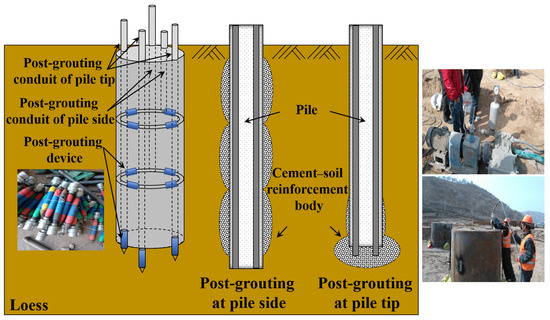
Figure 12.
Post-grouting method.
As shown in Figure 12, the reinforcement of the cast-in-place piles by post-grouting at the pile shaft is mainly reflected in the following three aspects: (1) The slurry solidifies the mudcake on the shaft of the pile and fills and compacts the voids between the pile and the soil, effectively improving the shear strength of the soil on the shaft of the pile. (2) The slurry solidifies the soil around the pile, alters the physical and mechanical properties of the soil, and increases the horizontal effective stress of the soil around the pile. (3) The upward reflux, downward penetration, and lateral diffusion of the slurry form a circumferential cement–soil reinforcement body with the soil around the pile, increasing the side area of the pile and thereby enhancing its bearing capacity on the shaft.
3.3. Coating Method
The coating method can be adopted to reduce the influence of negative skin friction on the pile foundations in the collapsible loess areas after immersion. However, the coating method is mainly applicable to precast piles.
As shown in Figure 13, before coating, the position of the neutral point needs to be determined through field tests, theoretical calculations, or relevant specifications to obtain the coating range. The coatings can be a mixture of paraffin oil and machine oil, polymer nanomaterials, paints or asphalt, etc. [45,46,47,48].
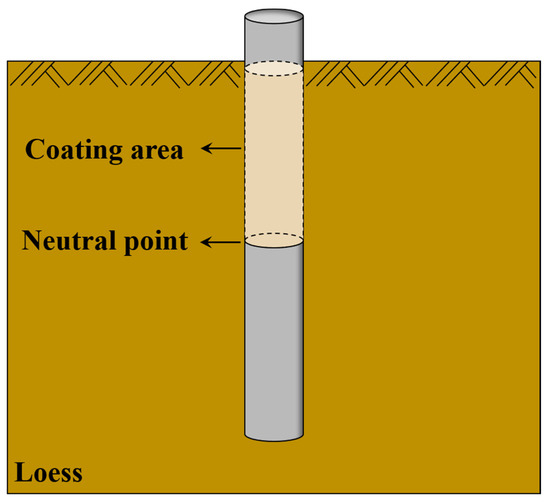
Figure 13.
Coating method.
3.4. Drilling Pre-Immersion Method
The pre-immersion method takes advantage of the characteristic that collapsible loess undergoes collapsible deformation when immersed [16]. Before construction, a large area of the site is immersed to cause the soil to undergo collapsible deformation and eliminate the collapsibility of the loess. This can reduce the influence of negative skin friction on pile foundations in the collapsible loess areas after immersion. However, the traditional pre-immersion method has some drawbacks such as a long immersion period and slow stabilization of settlement deformation after immersion treatment, resulting in excessive water consumption and an overly long construction period.
As shown in Figure 14, the drilling pre-immersion method was improved based on the traditional pre-immersion method [49]. By forming water immersion holes through drilling, the infiltrating water can directly act on the deep soil layer and accelerate the collapsible deformation rate of the deep soil layer. It is beneficial for controlling the amount of water required for the immersion treatment and also for controlling the depth of the treated soil layer.
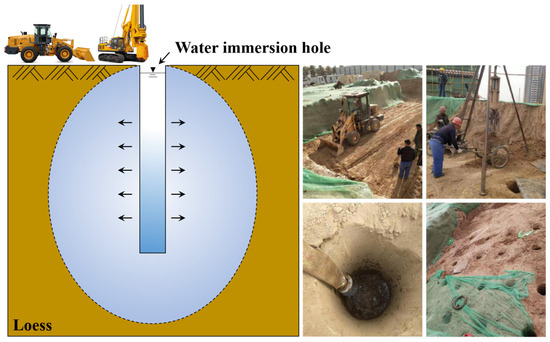
Figure 14.
Drilling pre-immersion method.
3.5. Pneumatic-Vibratory Probe Compaction Method
The pneumatic-vibratory probe compaction method, proposed by Gao et al. [50,51,52], is an environmentally friendly and resource-saving technology for eliminating the collapsibility of loess. This construction method is not only convenient but also has a significant reinforcement effect and has outstanding economic and environmental benefits. This can reduce the influence of negative skin friction on pile foundations in the collapsible loess areas after immersion.
As shown in Figure 15, the vibrating rod generates vertical oscillation under the excitation force of the vibrating hammer and penetrates into the foundation soil at a constant speed under the synergy of pneumatic action. During this process, the vibrating rod transmits the vibration energy to the surrounding soil in the form of body waves and surface waves, including compression waves, shear waves, and Rayleigh waves. Compression waves exert a compaction effect on the soil. Shear waves cause shear deformation of the soil, resulting in the rearrangement of soil particles, and accelerate the destruction of the soil structure through the pneumatic effect to achieve redistribution. The soil eventually tends to be compact under the synergistic effect of pneumatic. In addition, the resonance of the “vibration hammer-vibrating rod-soil” system can be generated by adjusting the vibration frequency thereby achieving the best compaction effect.

Figure 15.
Pneumatic-vibratory probe compaction method.
3.6. Dynamic Compaction Method
Before the construction of the pile foundations, the dynamic compaction method can be adopted to eliminate the collapsibility of the collapsible loess foundations.
As shown in Figure 16, the rammer is used to repeatedly fall from a height to generate ramming energy, which destroys the structure of loess, causes the rearrangement and redistribution of soil particles until they become compaction, eliminates the collapsibility of the loess, and improves the bearing capacity of the foundation. The down-hole dynamic compaction method first uses machinery to drill holes to a predetermined depth, and then fills the layers with materials [53]. Pointed cone-shaped or olive-shaped rammers are used to compact the filling materials to form compaction pile bodies, and by compacting the soil between the piles, eliminate the collapsibility of the loess and improve the bearing capacity of the loess foundation. The down-hole dynamic compaction method can make full use of inorganic solid wastes, such as construction and industrial waste, to reduce environmental pollution.
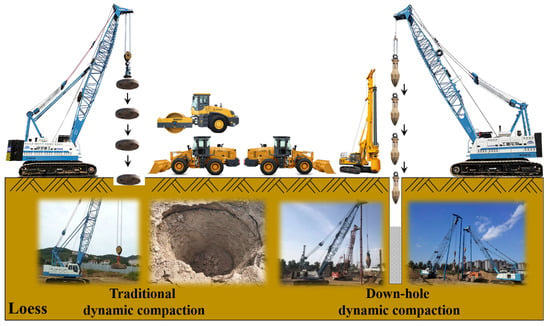
Figure 16.
Dynamic compaction method.
3.7. Replacement Method
When the thickness of the collapsible loess is relatively small, the construction of the pile foundations can be carried out after treatment by the replacement method [54].
The following process is shown in Figure 17: Excavate the collapsible loess within a certain range, and backfill it with stable, non-corrosive, high-strength materials. Compact the backfill materials layer by layer to form local or overall cushions to eliminate the collapsibility of the loess affected by water immersion. Backfill materials such as plain soil, lime soil, and cement soil can be utilized. The cushion layer can also be used in combination with the anti-seepage film to effectively eliminate collapsibility or effectively block water immersion.
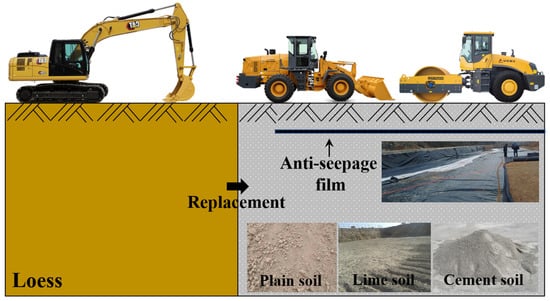
Figure 17.
Replacement method.
3.8. Physicochemical Reinforcement Method
Before the construction of the pile foundations, the physicochemical reinforcement method can be adopted to eliminate the collapsibility of the collapsible loess foundations.
Based on the theories of physical–chemical mechanics, stable curing materials are added to collapsible loess to reduce pore volume and optimize the contact mode of soil particles [55,56,57,58,59,60,61,62,63,64,65,66,67], and to improve the mechanical properties and stability of loess, as well as to solve the problems of collapsibility, strength, and stability of loess.
4. Conclusions
(1) The collapsible deformation caused by the loess after immersion is a process. It does not experience significant collapsible deformation as soon as it encounters water. it gradually increases over time and eventually reaches a stable state. The degree of collapsible deformation is related to the duration of immersion, external load, boundary conditions, and soil layer depth.
(2) The ultimate load and settlement of the pile foundation under the loading condition are 1.06 times and 7.78 times those of the pile foundation under the immersion–loading condition, respectively. Therefore, it is suggested to adopt the pile foundation design method controlled by the settlement.
(3) The axial force distribution laws of the piles under different loads, whether in loading conditions or immersion–loading conditions, exhibit similar patterns. Whether the collapsible loess site is immersed or not can only change the value and transfer rate of the axial force of the pile foundation but cannot change its transfer law. The collapsible deformation will increase the utilization rate of the pile tip resistance.
(4) To bear the existing superstructure load of the bridge and the negative skin friction caused by the collapsible settlement of the loess around the piles due to immersion, the relative displacement between the pile and the soil increases, and the pile will bear greater compressive deformation and may even be damaged.
(5) In order to effectively prevent the influence of water immersion in collapsible loess sites on the existing highway bridge pile foundations, eight preventive measures for reducing negative skin friction are proposed, including new types of piles, the post-grouting method, the coating method, the drilling pre-immersion method, the pneumatic-vibratory probe compaction method, the dynamic compaction method, the replacement method, and the physicochemical method. However, physicochemical methods are used less in actual engineering and still need further research.
Author Contributions
H.B.: Writing—Original Draft, Data Curation, Visualization, Methodology, Investigation, Conceptualization. J.W.: Writing—Review and Editing, Project Administration, Funding Acquisition. All authors have read and agreed to the published version of the manuscript.
Funding
This research was funded by the Science and Technology Project of Shaanxi Provincial Department of Transportation (Grant No. 24-21K and 22-24K), and the Fundamental Research Funds for the Central Universities CHD (Grant No. 310821173701).
Data Availability Statement
Data are contained within the article.
Conflicts of Interest
The authors declare no conflicts of interest.
References
- Qiu, J.; Lu, Y.; Lai, J.; Guo, C.; Wang, K. Failure Behavior Investigation of Loess Metro Tunnel under Local-High-Pressure Water Environment. Eng. Fail. Anal. 2020, 115, 104631. [Google Scholar] [CrossRef]
- Sprafke, T.; Obreht, I. Loess: Rock, Sediment or Soil—What Is Missing for Its Definition? Quat. Int. 2016, 399, 198–207. [Google Scholar] [CrossRef]
- Xu, Z.; Cai, N.; Li, X.; Xian, M.; Dong, T. Risk Assessment of Loess Tunnel Collapse during Construction Based on an Attribute Recognition Model. Bull. Eng. Geol. Environ. 2021, 80, 6205–6220. [Google Scholar] [CrossRef]
- Li, Y.; Shi, W.; Aydin, A.; Beroya-Eitner, M.A.; Gao, G. Loess Genesis and Worldwide Distribution. Earth-Sci. Rev. 2020, 201, 102947. [Google Scholar] [CrossRef]
- Kameshwar, S.; Padgett, J.E. Multi-Hazard Risk Assessment of Highway Bridges Subjected to Earthquake and Hurricane Hazards. Eng. Struct. 2014, 78, 154–166. [Google Scholar] [CrossRef]
- Seo, J.; Hu, J.W.; Lee, J. Summary Review of Structural Health Monitoring Applications for Highway Bridges. J. Perform. Constr. Facil. 2016, 30, 04015072. [Google Scholar] [CrossRef]
- Zhou, Z.; Xie, Y. Experiment on Improving Bearing Capacity of Pile Foundation in Loess Area by Postgrouting. Adv. Civ. Eng. 2019, 2019, 9250472. [Google Scholar] [CrossRef]
- Zhou, Z.; Xu, F.; Lei, J.; Bai, Y.; Chen, C.; Xu, T.; Zhang, Z.; Zhu, L.; Liu, T. Experimental Study of the Influence of Different Hole-Forming Methods on the Bearing Characteristics of Post-Grouting Pile in Loess Areas. Transp. Geotech. 2021, 27, 100423. [Google Scholar] [CrossRef]
- Bachinilla, B.; Evangelista, A.; Siddhpura, M.; Haddad, A.N.; da Costa, B.B.F. High-Speed Railway Bridge and Pile Foundation: A Review. Infrastructures 2022, 7, 154. [Google Scholar] [CrossRef]
- Liu, C.; Yan, C.; Zheng, G.; Liu, T.; Yang, Y. Field Testing and Numerical Analysis of Supporting Performance of Oblique Piles Used in Pit Excavation. Int. J. Geomech. 2023, 23, 04023204. [Google Scholar] [CrossRef]
- Wang, Z.; Qiu, W. Characteristics of Wave Forces on Pile Group Foundations for Sea-Crossing Bridges. Ocean Eng. 2021, 235, 109299. [Google Scholar] [CrossRef]
- Xing, H.; Liu, L.; Luo, Y. Effects of Construction Technology on Bearing Behaviors of Rock-Socketed Bored Piles as Bridge Foundations. J. Bridge Eng. 2019, 24, 05019002. [Google Scholar] [CrossRef]
- Pan, L.; Zhu, J.-G.; Zhang, Y.-F. Evaluation of Structural Strength and Parameters of Collapsible Loess. Int. J. Geomech. 2021, 21, 04021066. [Google Scholar] [CrossRef]
- Liu, Z.; Lu, Q.; Qiao, J.; Fan, W. In Situ Water Immersion Research on the Formation Mechanism of Collapsible Earth Fissures. Eng. Geol. 2021, 280, 105936. [Google Scholar] [CrossRef]
- Wang, X.; Zhu, Y.; Huang, X. Field Tests on Deformation Property of Self-Weight Collapsible Loess with Large Thickness. Int. J. Geomech. 2014, 14, 04014001. [Google Scholar] [CrossRef]
- An, P.; Zhang, A.; Xing, Y.; Zhang, B.; Ni, W.; Ren, W. Experimental Study on Settling Characteristics of Thick Self-Weight Collapsible Loess in Xinjiang Ili Region in China Using Field Immersion Test. Soils Found. 2018, 58, 1476–1491. [Google Scholar] [CrossRef]
- Zhao, Z.; Ye, S.; Zhu, Y.; Tao, H.; Chen, C. Scale Model Test Study on Negative Skin Friction of Piles Considering the Collapsibility of Loess. Acta Geotech. 2022, 17, 601–611. [Google Scholar] [CrossRef]
- Cao, W.; Chen, Y.; Wolfe, W.E. New Load Transfer Hyperbolic Model for Pile-Soil Interface and Negative Skin Friction on Single Piles Embedded in Soft Soils. Int. J. Geomech. 2014, 14, 92–100. [Google Scholar] [CrossRef]
- Chiou, J.-S.; Wei, W.-T. Numerical Investigation of Pile-Head Load Effects on the Negative Skin Friction Development of a Single Pile in Consolidating Ground. Acta Geotech. 2021, 16, 1867–1878. [Google Scholar] [CrossRef]
- Ren, Y.; Li, Y.; Cui, W.; Guo, W.; Zhuang, D.; Cui, S.; Zhang, L. Analysis of Negative Skin Friction and Bending Moment on Batter Rock-Socketed Pile. Mar. Georesources Geotechnol. 2024, 42, 927–944. [Google Scholar] [CrossRef]
- Gang-qiang, K.; Hang, Z.; Han-long, L.; Xuan-ming, D.; Liang, R. A Simplified Approach for Negative Skin Friction Calculation of Special-Shaped Pile Considering Pile-Soil Interaction under Surcharge. J. Cent. South Univ. 2014, 21, 3648–3655. [Google Scholar] [CrossRef]
- Hajitaheriha, M.M.; Jafari, F.; Hassanlourad, M.; Motlagh, A.H. Investigating the Reliability of Negative Skin Friction on Composite Piles. Civ. Eng. Infrastruct. J.-CEIJ 2021, 54, 23–42. [Google Scholar] [CrossRef]
- Ha, M.M.H.; Hassanlourad, M. Numerical modeling of the negative skin friction on single vertical and batter pile. Acta Geotech. Slov. 2015, 12, 46–55. [Google Scholar]
- Shawky, O.; Altahrany, A.I.; Elmeligy, M. Improved Pile Geometry to Reduce Negative Skin Friction on Single Driven Pile and Pile Groups Subjected to Lateral Loads. Geotech. Geol. Eng. 2022, 40, 4487–4516. [Google Scholar] [CrossRef]
- Liu, Y.; Yang, P.; Xue, S.; Pan, Y. Influence of Dredger Fill Self-Consolidation on Development of Negative Skin Friction of Piles. Arab. J. Geosci. 2020, 13, 725. [Google Scholar] [CrossRef]
- Bartz, J.R.; Blatz, J.A. Comparison of Canadian Highway Bridge Design Code and AASHTO LRFD Bridge Design Specifications Regarding Pile Design Subject to Negative Skin Friction. Can. Geotech. J. 2020, 57, 1092–1098. [Google Scholar] [CrossRef]
- Mohsen, A.H.; Albusoda, B.S. An Experimental Study Evaluating the Negative Skin Friction on Single and Group of Close-Ended Circular Pipe Piles Embedded in Gypseous Soil. Transp. Infrastruct. Geotechnol. 2024, 11, 1903–1927. [Google Scholar] [CrossRef]
- Guan-bao, Y.; Wen-qiang, Z.; Zhen, Z. Investigation on Distribution of Negative Friction of Frictional Piles in Large Filling Sites. Rock Soil Mech. 2019, 40, 440–448. [Google Scholar] [CrossRef]
- Jeong, S.; Ko, J.; Lee, C.; Kim, J. Response of Single Piles in Marine Deposits to Negative Skin Friction from Long-Term Field Monitoring. Mar. Georesources Geotechnol. 2014, 32, 239–263. [Google Scholar] [CrossRef]
- Jin, X.; Wang, T.-H.; Cheng, W.; Luo, Y.; Zhou, A. A Simple Method for Settlement Evaluation of Loess-Pile Foundation. Can. Geotech. J. 2019, 56, 1690–1699. [Google Scholar] [CrossRef]
- Gao, D.; Zhao, K.; Ma, B.; Han, Z.; Fan, J. Research on the Bearing Behavior of Single Pile in Self-Weight Collapsible Loess Areas. PLoS ONE 2023, 18, 0290878. [Google Scholar] [CrossRef] [PubMed]
- Wang, X.; Wang, X.; Li, J.; Liu, D.; Zhang, Y.; Jiang, D. Field Test Study of Performance of Bored Piles in Collapsible Loess. Appl. Sci. 2023, 13, 13113. [Google Scholar] [CrossRef]
- Xing, H.; Liu, L. Field Tests on Influencing Factors of Negative Skin Friction for Pile Foundations in Collapsible Loess Regions. Int. J. Civ. Eng. 2018, 16, 1413–1422. [Google Scholar] [CrossRef]
- Lei, J.; Zhou, Z.; Han, D.; Zhu, S.; Feng, H.; Wang, K.; Tian, Y. Centrifuge Model Tests and Settlement Calculation of Belled and Multi-Belled Piles in Loess Area. Soil Dyn. Earthq. Eng. 2022, 161, 107425. [Google Scholar] [CrossRef]
- Moayedi, H.; Mosallanezhad, M. Uplift Resistance of Belled and Multi-Belled Piles in Loose Sand. Measurement 2017, 109, 346–353. [Google Scholar] [CrossRef]
- Gao, G.; Gao, M.; Chen, Q.; Yang, J. Field Load Testing Study of Vertical Bearing Behavior of a Large Diameter Belled Cast-in-Place Pile. Ksce J. Civ. Eng. 2019, 23, 2009–2016. [Google Scholar] [CrossRef]
- Mohajerani, A.; Bosnjak, D.; Bromwich, D. Analysis and Design Methods of Screw Piles: A Review. Soils Found. 2016, 56, 115–128. [Google Scholar] [CrossRef]
- Wang, X.; Chen, T.; Wang, X.; Li, J.; Liu, D.; Zhang, Y.; Jiang, D. Performance of Screw Piles in Thick Collapsible Loess. Case Stud. Constr. Mater. 2023, 19, e02263. [Google Scholar] [CrossRef]
- Zhou, J.; Gong, X.; Zhang, R.; El Naggar, M.H.; Wang, K. Field Behavior of Pre-Bored Grouted Planted Nodular Pile Embedded in Deep Clayey Soil. Acta Geotech. 2020, 15, 1847–1857. [Google Scholar] [CrossRef]
- Zhou, J.; Yu, J.; Gong, X.; Yan, T. Field Tests on Behavior of Pre-Bored Grouted Planted Pile and Bored Pile Embedded in Deep Soft Clay. Soils Found. 2020, 60, 551–561. [Google Scholar] [CrossRef]
- Zhou, J.; Wang, K.; Gong, X.; Zhang, R. Bearing Capacity and Load Transfer Mechanism of a Static Drill Rooted Nodular Pile in Soft Soil Areas. J. Zhejiang Univ. Sci. A 2013, 14, 705–719. [Google Scholar] [CrossRef]
- Zhou, J.; Gong, X.; Wang, K.; Zhang, R.; Yan, J. Testing and Modeling the Behavior of Pre-Bored Grouting Planted Piles under Compression and Tension. Acta Geotech. 2017, 12, 1061–1075. [Google Scholar] [CrossRef]
- Zhou, J.; Gong, X.; Wang, K.; Zhang, R. Shaft Capacity of the Pre-Bored Grouted Planted Pile in Dense Sand. Acta Geotech. 2018, 13, 1227–1239. [Google Scholar] [CrossRef]
- Zhou, J.; Gong, X.; Zhang, R. Model Tests Comparing the Behavior of Pre-Bored Grouted Planted Piles and a Wished-in-Place Concrete Pile in Dense Sand. Soils Found. 2019, 59, 84–96. [Google Scholar] [CrossRef]
- Feng, Z.; Hu, H.; Zhao, R.; He, J.; Dong, Y.; Feng, K.; Zhao, Y.; Chen, H. Experiments on Reducing Negative Skin Friction of Piles. Adv. Civ. Eng. 2019, 2019, 4201842. [Google Scholar] [CrossRef]
- Kurnoskina, N. Use of Antifriction Coatings for Reducing Friction between Pile Lateral Surfaces and Soil. Soil Mech. Found. Eng. 1983, 20, 236–239. [Google Scholar] [CrossRef]
- Tawfiq, K.S.; Caliendo, J.A. Bitumen Coating versus Plastic Sheeting for Reducing Negative Skin Friction. J. Mater. Civ. Eng. 1995, 7, 69–81. [Google Scholar] [CrossRef]
- Khare, M.; Gandhi, S.; Student, P. Skin Friction of Piles Coated with Bituminous Coats. In Contemporary Issues in Deep Foundations; ASCE Library: Reston, VI, USA, 2007. [Google Scholar] [CrossRef]
- Zhi, B.; Wang, X.; Wei, P.; Li, Z.; Wang, P.; Xiong, K.; Zhang, H.; Liu, E. A New Method for Reducing Collapsibility of Loess Foundation with Thicker Deposit: The Borehole Preimmersion Method. Adv. Civ. Eng. 2021, 2021, 6636347. [Google Scholar] [CrossRef]
- Gao, C.; Du, G.; Liu, S.; He, H.; Zhang, D. The Microscopic Mechanisms of Treating Collapsible Loess with Vibratory Probe Compaction Method. Transp. Geotech. 2021, 27, 100492. [Google Scholar] [CrossRef]
- Gao, C.; Du, G.; Liu, S.; Zhang, D.; Zhang, K.; Zeng, B. Field Study on the Treatment of Collapsible Loess Using Vibratory Probe Compaction Method. Eng. Geol. 2020, 274, 105715. [Google Scholar] [CrossRef]
- Guangyin, D.; Changhui, G.; Songyu, L.; Huangsong, P.; Qian, G.; Tao, L. Resonance Vibration Approach in Soil Densification: Laboratory Experiences and Numerical Simulation. Earthq. Eng. Eng. Vib. 2021, 20, 317–328. [Google Scholar] [CrossRef]
- Zhang, Y.; Yao, Y.; Ma, A.; Liu, C. In Situ Tests on Improvement of Collapsible Loess with Large Thickness by down-Hole Dynamic Compaction Pile. Eur. J. Environ. Civ. Eng. 2020, 24, 156–170. [Google Scholar] [CrossRef]
- Hu, J.; Liu, H.; Ren, W.; Zhang, A.; Mi, W.; Liang, Z.; Pan, L.; Xie, H.; Han, J.; Yang, T. An Experimental Study for Evaluation of Collapsible Loess Roadbed Replacement Method Using Lightweight Soil. Bull. Eng. Geol. Environ. 2023, 82, 359. [Google Scholar] [CrossRef]
- Xu, J.; Li, Y.; Wang, B.; Wang, Z.; Wang, S. Microstructure and Permeability of Bentonite-Modified Loess after Wetting-Drying Cycles. Int. J. Geomech. 2023, 23, 04023052. [Google Scholar] [CrossRef]
- Li, G.; Hou, X.; Mu, Y.; Ma, W.; Wang, F.; Zhou, Y.; Mao, Y. Engineering Properties of Loess Stabilized by a Type of Eco-Material, Calcium Lignosulfonate. Arab. J. Geosci. 2019, 12, 700. [Google Scholar] [CrossRef]
- Rahmani, A.; Hazzab, A.; Aimer, H.; Ghenaim, A.; Terfous, A. Improvement of physical-chemical and rheological properties of Ghardaïa loess (Southern Algeria) using bentonite clay and lime. Clays Clay Miner. 2020, 68, 499–512. [Google Scholar] [CrossRef]
- Dassekpo, J.-B.M.; Zha, X.; Zhan, J. Synthesis Reaction and Compressive Strength Behavior of Loess-Fly Ash Based Geopolymers for the Development of Sustainable Green Materials. Constr. Build. Mater. 2017, 141, 491–500. [Google Scholar] [CrossRef]
- Yuan, K.; Ni, W.; Lü, X.; Zhu, M. Experimental Study on the Performance of the Modified Loess by Polypropylene Fiber Mixed with Bentonite and Cement. Bull. Eng. Geol. Environ. 2022, 81, 302. [Google Scholar] [CrossRef]
- Yuan, K.; Ni, W.; Zhao, L.; Wang, H. Silica Fume Stabilized Loess: Mechanical Properties, Microstructural Evolution and Environmental Analysis. Sustain. Mater. Technol. 2023, 36, e00604. [Google Scholar] [CrossRef]
- Kong, R.; Gao, L.; Zhao, W.; Zhao, B. Multi-Scale Analysis of Geotechnical and Physicochemical Changes in Loess Caused by Nano-SiO2 Pile Migration. Front. Earth Sci. 2021, 9, 747317. [Google Scholar] [CrossRef]
- Dong, C.; Huang, Y.; Zhang, W.; Tang, X.; Gu, Y.; Feng, Y. Behavioral Evaluation on the Engineering Properties of Lignin-Stabilized Loess: Reuse of Renewable Materials. Constr. Build. Mater. 2023, 369, 130599. [Google Scholar] [CrossRef]
- Hou, Y.; Li, P.; Wang, J. Review of Chemical Stabilizing Agents for Improving the Physical and Mechanical Properties of Loess. Bull. Eng. Geol. Environ. 2021, 80, 9201–9215. [Google Scholar] [CrossRef]
- Zhang, Y.; Hu, Z.; Li, L.; Xue, Z. Improving the Structure and Mechanical Properties of Loess by Acid Solutions—An Experimental Study. Eng. Geol. 2018, 244, 132–145. [Google Scholar] [CrossRef]
- Luo, L.; Wang, X.; Xue, C.; Wang, D.; Lian, B. Laboratory Experiments and Numerical Simulation Study of Composite-Material-Modified Loess Improving High-Speed Railway Subgrade. Polymers 2022, 14, 3215. [Google Scholar] [CrossRef]
- Liu, Y.; Tang, C.; Wen, J.; Guo, H.; Fan, H. Mechanical Characterization and Water Stability of Loess Improved by Bio-Based Materials: An Eco-Friendly Approach. Sci. Total Environ. 2024, 921, 171111. [Google Scholar] [CrossRef]
- Xue, C.; Wang, X.; Lian, B.; Luo, L.; Liu, K. Research on the Mechanism of Composite Improvement of Loess Based on Quantitative Analysis of Microstructure and Mechanical Strength. Constr. Build. Mater. 2023, 379, 131215. [Google Scholar] [CrossRef]
Disclaimer/Publisher’s Note: The statements, opinions and data contained in all publications are solely those of the individual author(s) and contributor(s) and not of MDPI and/or the editor(s). MDPI and/or the editor(s) disclaim responsibility for any injury to people or property resulting from any ideas, methods, instructions or products referred to in the content. |
© 2024 by the authors. Licensee MDPI, Basel, Switzerland. This article is an open access article distributed under the terms and conditions of the Creative Commons Attribution (CC BY) license (https://creativecommons.org/licenses/by/4.0/).